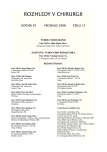Polycystosis of the Liver
Authors:
M. Loveček; R. Havlík; M. Konečný 1; Č. Neoral
Authors‘ workplace:
I. chirurgická klinika FN a LF UP Olomouc, přednosta: doc. MUDr. Čestmír Neoral, CSc.
; II. interní klinika FN a LF UP Olomouc, přednosta: doc. MUDr. Vlastimil Procházka, Ph. D.
1
Published in:
Rozhl. Chir., 2008, roč. 87, č. 12, s. 619-621.
Category:
Monothematic special - Original
Overview
Introduction:
Polycystic liver disease presents as follows: either associated with autosomal dominant polycystic kidney disease (ADPKD) with incidences ranging from 1 out of 400 to 1 out of 1000 subjects, or as an autosomal dominant polycystic liver disease (ADPLD) with incidences below 0.01%. Polycystic liver disease is usually asymptomatic, however, hepatomegaly may result in debilitating symptoms of abdominal pains, early satiety, nausea, dyspnoe, ascites, biliary obstruction or lower body edema. The complications include ruptures and infections of the cysts. Serious symptoms or complications affect cca 20% of the polycystic liver patients. These symptomatic cases require surgical management, most commonly including laparoscopic fenestrations, combined non-anatomical liver resections with fenestration, or, in liver failure cases, liver transplantation. The disease is managed in hepatobiliary surgical centers.
Subjects, Classification and Results:
The authors present a group of three (two female and one male) patients. The study group included all types of the polycystic liver disease. All symptoms of the studied subjects resulted from compression of surrounding organs- the stomach and bile ducts. Therapy included fenestration with partial laparoscopic resection, as well as open resections with fenestration.
The three-type polycystic liver disease classification is based on CT assessment (according to Gigot) of the stage and character of the liver parenchyma affection. The classification is based on the number and size of the cysts and on the extent of the unaffected liver parenchyma.
A short-term assessment (8–10 months postoperatively) showed significant postoperative symptomatic improvement in all of the three subjects. Compression symptoms resolved, relapsing cholangitides in a patient with his bile ducts obstruction related to a duodeno-biliary stent, were managed by resection of the cystic right liver lobe and removal of the plastic stent, with consequent release of the bile ducts. Further course of the disease will be monitored.
Conclusion:
Management of the polycystic liver disease patients requires individual approach, based on the stage and character of the disease. The therapeutic rationale is to resolve the symptoms and prevent complications. Post-surgical liver failure requires liver transplantation.
Key words:
liver polycystosis – resection – transplantation
Sources
1. Farges, O., Menu, Y., Benhamou, J. P. Non-parasitic cystic disease of the liver and intrahepatic biliary tree. P. 1245–1260. In: Blumgart, L. H.: Surgery of the liver and biliray tract. W. B. Saunders Company Ltd. London 2000. ISBN 0-7020-25011
2. Russell, R. T., Pinson, C. W. Surgical management of polycystic liver disease. World J. Gastroenterol., 2007; 38, 13, 5052–5059.
3. Hoevenaren, J. A., Wester, R., Schrier, R. W., McFann, K., Doktor, R. B., Drenth, J. P., Everson, G. T. Polycystic liver: clinical characteristics of patiens with isolated polycystic liver disease compared with patiens with polycystic liver and autosomal dominant polycystic kidney disease. Liver. Int., 2008, 28, 2, 264–270.
4. van Keimpema, L., Ruurda, J. P., Ernst, M. F., van Geffen, H. J., Drenth, J. P. Laparoscopic fenestration of liver cysts in polycystic liver disease results in median volume reduction of 12,5%. Indian J. Pathol. Microbiol., 2007, 50, 2, 371–373.
5. Malur, P. R., Bannur, H. B., Sant, A. N., Mastiholimath, R. D. Isolated polycystic liver disease – a rare entity: report of a case. Scand. J. Gastroenterol., 2007, 12, 10, 1–6.
Labels
Surgery Orthopaedics Trauma surgeryArticle was published in
Perspectives in Surgery

2008 Issue 12
- Metamizole vs. Tramadol in Postoperative Analgesia
- Metamizole at a Glance and in Practice – Effective Non-Opioid Analgesic for All Ages
- Current Insights into the Antispasmodic and Analgesic Effects of Metamizole on the Gastrointestinal Tract
Most read in this issue
- Polycystosis of the Liver
- Malignant Melanoma Brain Metastasis – Diagnostic Difficulties
- Preoperative Mechanical Preparation of the Colon and Antibiotic Prophylaxis in Colorectal Surgery
- Distal Radius Fractures Managed by Osteosynthesis Using Intramedullary Nails – Initial Information
